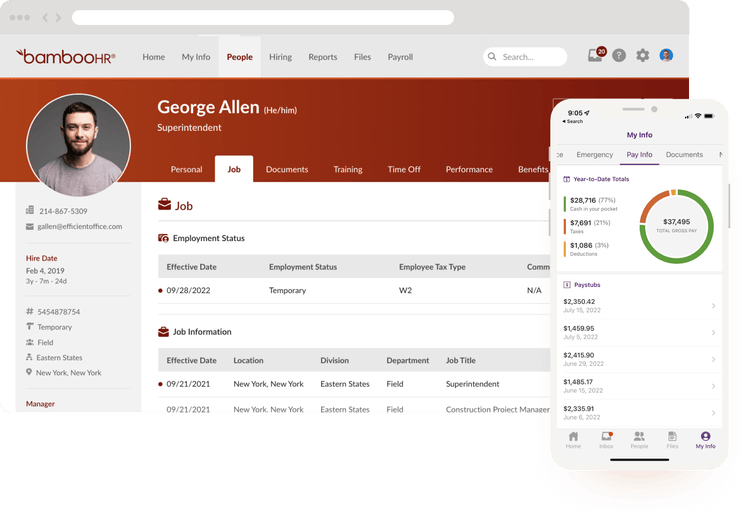
3 Ways to Build Employee Retention in Construction
A Concrete Plan for Building a Strong Construction Company
If your phone’s been ringing a lot more lately, you’re not alone. Demand for construction work has soared since the pandemic. According to Deloitte’s 2022 Engineering and Construction Industry Outlook report, construction spending hit $1.57 trillion in July 2021—a record high.
While business may be booming, you’re probably finding it increasingly difficult to hire skilled workers. The Associated General Contractors of America (AGC) reports that 91 percent of construction firms are having trouble filling open positions, particularly craftsmen who perform the bulk of onsite construction work. According to the U.S. Bureau of Labor Statistics (BLS), there are approximately 168,500 openings for construction workers each year.
You work hard to build your team, and losing a skilled worker to a competitor or seasonal turnover can be devastating, derailing work schedules and delaying project timelines.
Read on to discover three key initiatives to create an employee retention strategy that can keep your crew intact.

Create a Formal Onboarding Process
According to a study by Gallup, 88% of employees say their company’s onboarding program fell short. Instead of just tossing your new hire a hardhat, experts recommend building a structured process with checkpoints and milestones.
Research suggests that onboarding is worth the investment. According to the Society for Human Resource Management (SHRM), your employees are 58% more likely to stick around for three or more years if you take the time to create a formal onboarding process.
Set Up a Buddy Program
Being the new person can feel awkward. They are learning their way around the job site and getting used to how things are done. Having to ask a manager a lot of questions can feel intimidating.
Instead, pair new employees with a buddy or mentor to help them become acclimated to their job. 56% of employees said having a buddy or mentor helped them be more productive and effective in their first week on the job.
A buddy can also help improve the safety of a job site by training new employees on safety programs and shadowing them for a day or two to make sure they’re compliant with procedures and regulations. According to the BLS, first-year construction workers account for 60 percent of the total number of injuries.


Schedule Regular Check-Ins
According to a study by Jobvite, 1 in 3 employees leave within the first 90 days of employment.
The top reasons for leaving include:
- The day-to-day role wasn’t what they expected (41%)
- An incident or bad experience occurred (35%)
- Company culture was disappointing (34%)
- Company leadership was unsatisfactory (32%)
Nobody wants a revolving door. Instead, have regular check-ins with employees to identify and address problems before they lead to an employee’s departure.
During these meetings, ensure an environment where crew supervisors and employees feel comfortable sharing concerns to reduce issues on site. The goal is to establish a workplace where there is mutual respect between managers and employees from the beginning.
Digitize the Process
If your construction firm still uses printouts for new hires, it’s time to move into the 21st century. Not only does manual paperwork take more time to complete, it can easily be misplaced, which could cause delays in payroll.
Instead, consider adopting an online onboarding system that will speed up the process. New hires can submit forms instantly from their phones and input direct deposit information, ensuring they get paid on time. Digital onboarding systems also keep track of forms to make sure everything is completed.

Offer a Competitive Compensation Package
High inflation and a competitive talent market make your compensation strategy a critical factor in retaining your workforce. If an employee can get a higher rate or better benefits by working for your competitor, they’re more likely to leave. Even a bump of 50 cents an hour can add up to an extra $1,000 in a year.
Employees expect to be paid what they’re worth. If you haven’t updated your compensation strategy in the past year, it’s time to revisit the rates, benefits, and perks you offer your workers.


Pay Market Rates
Start by making sure you’re paying a wage that is consistent with the market. If you’re not sure where your rates fall, the BLS has outlined the average pay grade of employees in the construction industry. Their tables can be a good way to ensure your pay structure is meeting industry benchmarks.
It’s also possible to learn what your competitors are offering. Visit a website like PayScale or Glassdoor where current or former employees can reveal their real wages.
Provide Comprehensive Benefits
Monetary compensation is important, but it’s not always the deciding factor in retention. Providing benefits employees want helps improve employee loyalty.
Traditional benefits like health, life, and disability insurance, PTO, and retirement contributions are essential.
Construction industry jobs involve more physical labor than other industries, so be sure to have better-than-average health care or disability offerings. If an employee knows you care about their health and will support them if they become sick or injured, they’re more likely to stay.
But don’t stop there. In a survey by BambooHR:
- 35% of employees value rewards
- 32% want employee performance bonuses
- 30% like flexible working arrangements
- 23% want mental health services
- 22% value paid vacation time
- 22% want increased paid time off

Then Throw in Some Perks
Beyond traditional benefits, consider offering other perks. For example, you might provide a comfortable space where your staff can take breaks or access to water and snacks on the job site.
Companies that think outside the box can gain a competitive edge in employee retention. Perks like free gym memberships, tools, cell phone allowance, tuition reimbursement for degrees in construction management, or certificates for auto-detailing or restaurants may encourage employees to stick around.
Develop a Positive Culture
It doesn't matter whether you're a small local construction firm or a large national contractor, you’ve got to find ways to make sure your employees are happy. That starts with building a strong culture. According to SHRM, a toxic culture is more impactful than compensation when it comes to an employee deciding to leave a job.
Since construction workers don't often have a business email address where you can engage them with weekly email newsletters, communication and culture building needs to happen in different and intentional ways.

Be Clear About Your Values
Your company may have a mission statement, which is a concise explanation of why your company exists. But do you have a values statement? According to SHRM, a values statement lists the core principles that guide and direct your organization and its culture. Your values will inform decision-making and establish standards and conduct employees should uphold.
Once you’ve crafted your values statement, post it on your job site, website, and in your offices. When your team members are reminded of your values on a consistent basis, they’ll be more likely to follow them.
Leadership shapes your culture, and your values statement only holds weight when it’s modeled from the top. Make sure your managers “walk the talk.” If you start seeing a higher than normal turnover, especially on a specific job site, there may be a disconnect between your culture and your values statement. Do something about it immediately. If you’re not already onsite, visit construction projects for culture and values checks. Employees who see a disconnect between company values and leaders’ behavior will be more likely to leave.
A good example of a value statement comes from Anchor Construction Corporation, which shares its four core values on its website
- Safety: Creating a safe and productive work environment is a priority. We never compromise safety at Anchor.
- Integrity: Our word is our bond with one another, as well as our customers. Doing what we say we’ll do every time—honestly and reliably—is the only way we operate.
- Quality: At Anchor, we strive to adhere to the highest standards of excellence. Our team is challenged every day and every shift to do our best according to the required processes, procedures, and customer requirements.
- Teamwork: We are all about teamwork. Providing high-quality training programs, benefits, and growth opportunities so our team can experience long, fulfilling careers is a cornerstone of our success.

Train Your Managers
It’s been said that employees don’t quit jobs; they quit bosses.
According to the Construction Industry Institute, the construction industry will continue to tackle worker shortages until it implements effective management strategies. Often, companies promote strong workers to supervisory roles. Unfortunately, the skills it takes to do a job well aren’t the same skills needed to manage and develop others. Invest in your managers by getting them training in communication, motivation, and engagement.
For example, managers should look for and acknowledge hard work instead of only providing correction, criticism, or negative feedback. Encourage managers to call out and reward employees for jobs done well.
Keep in mind that rewards don’t have to be monetary. An acknowledgement during a team meeting or shout out on social media can be impactful. An added bonus is that public acknowledgements on your social media pages will enhance your employer brand.
Provide Learning Opportunities
Compliance requirements in the construction industry are constantly shifting, requiring constant checks and training. Make sure that your company is a place where employees can improve their craft and progress in their career while staying current with the latest industry standards.
Start new hires off right by offering on-the-job training. More than 75% of new employees said on-the-job training was the most important thing they need to become productive quickly.
Create a training program that helps employees improve their skills and learn new ones. The more skills your employees learn, the more confident they'll become, helping them work more productively with less supervision. By cross-training employees, your company will be in better shape to withstand natural attrition. What’s more, employees will be more likely to stay put if they see that you’re investing in their expertise and knowledge.
Set up clear pathways for advancement based on performance and skill sets. According to Indeed, “searching for job growth and career advancement” is one of the top reasons people quit their jobs. Employees want to grow in their careers, and strong employers offer continued education, like workshops, seminars, lectures, or even tuition reimbursement.

Train people well enough so they can leave; treat them well enough, so they don’t want to.
Richard Branson
Employee Satisfaction Creates Employee Retention
Recruiting and turnover costs can be high. When you improve your employee retention rate, you protect your schedules, reputation, and profits.
According to economists at Warwick University, happy employees are more productive in their jobs and are more likely to stay. By implementing an employee retention plan, you’re not growing a strong team; you’re making an investment in your company and its future.

Become the place people want to join and stay.
BambooHR gives you the right tools to invest in every aspect of your employee experience.
Employee Satisfaction with eNPS®*
Gather data on how your people view their growth potential at your company.
Onboarding
Speed up the recruiting process—and wow new hires—with an award-winning applicant tracking system and intuitive onboarding.
Mobile App
Give your employees convenient, on the go access to HR info with the BambooHR® mobile app.
You’ve got big plans. We’ve got powerful tools.
See how BambooHR helps you focus on your people.